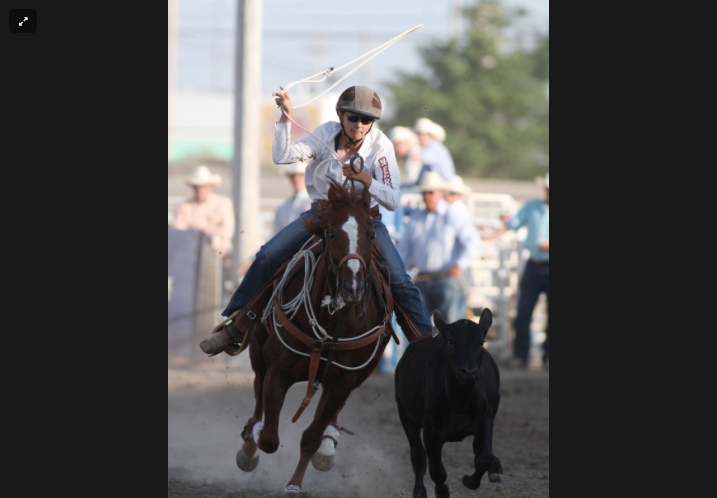*This story was featured in the Hastings Tribune on June 17, 2016.
Libby Winchell remembers all too well the first time she thought she was blind.
Libby, then just a sixth-grader in middle school, recalls waking up and not being able to see clearly.
Still, she woke up, completed her normal morning routine and went to school. It was only when her social studies teacher called upon her when she revealed to others about her vision problems.
“My social studies teacher asked me to read something and I couldn’t read it. I couldn’t read anything,” said Libby, 17, who is competing in this week’s Nebraska State Finals Rodeo at the Adams County Fairgrounds in Hastings. “She didn’t think I was for real.”
She wasn’t kidding.
Later that afternoon, she revealed her vision issues to her parents and was subsequently taken to the emergency room and began a battery of tests, which included an MRI, CAT scan and lumbar puncture.
With no luck on the prognosis, her mother, Shawna Winchell, 49, took her to the Children’s Hospital in Denver.
That drive from Scottsbluff to the Children’s Hospital in Denver became one of the biggest low points in Libby’s medical saga.
“After she had the lumbar puncture in our hometown and they punctured her six times … you’re supposed to clot and she didn’t clot,” Shawna said. “Her and I were driving to Denver and she was throwing up. That was our low point.”
Upon arriving at the hospital, Libby was diagnosed with optic neuritis, which is an inflammation of the optic nerve or the bundle of nerve fibers that transmits visual information from your eye to your brain. The condition had eliminated her ability to see and caused debilitating migraines.
“When I entered the hospital, my vision was 2400, which is legally blind,” Libby said.
To combat her optic neuritis, doctors prescribed her a regimen of steroids, which were intended to help with her vision problems. Instead, they unintentionally caused an already existent ulcer in her abdomen to perforate.
The perforation of her ulcer, Libby’s words “blew up her stomach,” and caused her situation to go from bad to worse.
“I woke up and went to the bathroom and it hit me,” Libby said. “My dad saw it and my stomach was black, so it was all air. They stopped one surgery and put me in another surgery. I was on the X-ray table and (the doctors) said ‘we need to get you in surgery now.’ ”
After a successful surgery, the ulcer was treated, but one issue still remained: Libby’s vision.
Once again, she was prescribed steroids and this time, the steroids, slowly but surely, helped repair her vision.
Despite her vision being repaired, the impact of her illnesses was certainly still being felt.
“She was a sick girl. She could care less about doing anything and that was a change that was very tough — knowing that wasn’t her,” Shawna said. “She was sick and sicker than we could ever imagine, so that was scary.”
Her illnesses certainly had an effect on both herself and her loved ones, but it also impacted something near-and-dear to her heart — rodeo.
Libby had missed a year of rodeo and felt a longing to get back to the sport she refers to as “her life.”
Still, her return — much like the previous year of her life — didn’t come without its fair share of challenges and hardships.
“Once I got out of the hospital, I competed and had a pretty good fall, but went back to the Children’s Hospital for a check up and they said that my optic nerve had swelled more and had gotten bigger,” Winchell said. “They said a fall could make it worse.”
After receiving news that a fall, which occurs as regularly as a bump or bruise in the sport of rodeo, could cause a step back in her progress, she made a decision.
She would forever compete while wearing a helmet.
Ever since, she, much like the horse she competes on, has hit the ground running.
“I came back my seventh-grade year in the spring and we went to junior high nationals. At that time, barrels were flat on the ground because my depth perception wasn’t very good,” Libby said. “I was relying on muscle memory coming back, just a lot of muscle memory.”
After finding herself back on a horse and back in the arena on a regular basis, Libby once again added another element to her riding attire. This time, it was a bell.
In the beginning, when her vision still wasn’t clear, she attached the bell to her saddle in order to alert riders that she was in the same area they were in. Now, she simply rides with it as a constant reminder – of both her past and what she’s overcome to reach this point.
“I have the bell, and it’s just for me,” Libby said. “And I just kind of kept it on there.”
Now, Libby appears light years away from her days of lying in a hospital bed and not being able to make out the faces in front of her.
Since returning full time she’s made junior high nationals (eighth grade), won a Nebraska state title and competed in nationals (freshman year) and picked up a third-place medal in state and finished reserve national champion in the goat-tying event (sophomore year).
This time around, she has her eyes set on a national championship crown.
“My dream right now is to win a state title and make it to nationals in all three of my events,” Libby said. “A national title in goat-tying would be great. I know what it feels like to be on top and I want to go back.”
Regardless of the outcome of her season, Libby as a vision for her future. She plans to compete in rodeo in college and wants to keep rodeo in her life for a long time.


